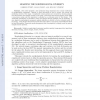Free Online Productivity Tools
i2Speak
i2Symbol
i2OCR
iTex2Img
iWeb2Print
iWeb2Shot
i2Type
iPdf2Split
iPdf2Merge
i2Bopomofo
i2Arabic
i2Style
i2Image
i2PDF
iLatex2Rtf
Sci2ools
141
click to vote
SIAMIS
2010
2010
Learning the Morphological Diversity
This article proposes a new method for image separation into a linear combination of morphological components. Sparsity in fixed dictionaries is used to extract the cartoon and oscillating content of the image. Complicated texture patterns are extracted by learning adapted local dictionaries that sparsify patches in the image. These fixed and learned sparsity priors define a non-convex energy and the separation is obtained as a stationary point of this energy. This variational optimization is extended to solve more general inverse problems such as inpainting. A new adaptive morphological component analysis algorithm is derived to find a stationary point of the energy. Using adapted dictionaries learned from data allows to circumvent some difficulties faced by fixed dictionaries. Numerical results demonstrate that this adaptivity is indeed crucial to capture complex texture patterns. Key words. Adaptive morphological component analysis, sparsity, image separation, inpainting, dictionary...
Related Content
| Added | 21 May 2011 |
| Updated | 21 May 2011 |
| Type | Journal |
| Year | 2010 |
| Where | SIAMIS |
| Authors | Gabriel Peyré, Jalal Fadili, Jean-Luc Starck |
Comments (0)

